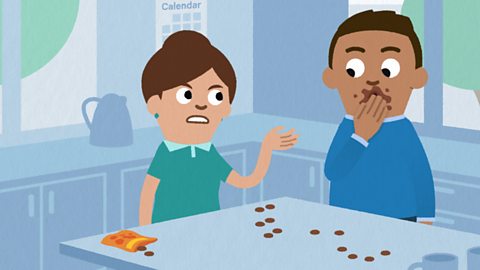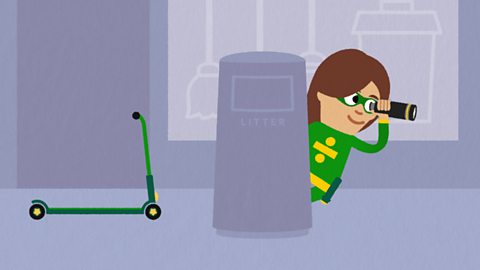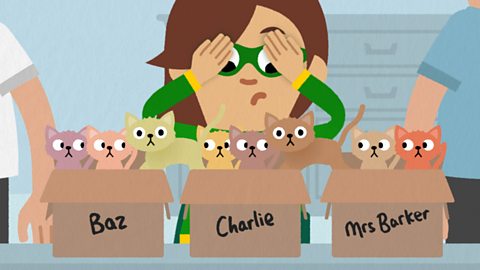Voiceover:
In a world without maths,a land where people forgot, who will save the day?
Mr Sharma:
Errrrr, Ooooo…1, 2, 3, 4, 5, where’s the next box? Aww why can’t I buy them separately?
Mrs Barker:
Morning. Just the one box of pencils today?
Mr Sharma:
Yes. I mean, I think yes. Maybe I need some more. Right, there we go.
Mrs Barker:
Are you sure you’ve got everything you need?
Mr Sharma:Yes, errr no, umm not sure. Err, hold on.
Mrs Barker:
Is that everything then?
Mr Sharma:
Ooo no, now that looks too many.
Mr Sharma:
I’m buying new pencils for the school but they only come in boxes of five. How do I know how many I’ve got? Oooohhh it’s hopeless.
Mrs Barker:
Don’t worry.
Mrs Barker:
There’s someone we can call.
Mrs Barker:
Is he here?
Mrs Barker:I can’t see. Multiplication Boy,please can you help Mr Sharma work out how many boxes he needs so I can get out of this pencil prison.
Narrator:
This is a tricky one. First of all, what needs doing?
Mr Sharma:
I’m buying new pencils for the school but they only come in boxes of five.
Mr Sharma:
How do I know how many I’ve got?
Narrator:
Hmm how can Multiplication Boy work out how many pencils Mr Sharma is buying without taking them out of the boxes and counting them?
Narrator:
Fives! Yes, I think you’re right. To work out how many pencils Mr Sharma is buying we need the 5 times table.There are five pencils in the first box.
It’s going to take a long time to draw all these pencils, so let’s use dots instead.So, 5 in the first box, 5 in the second box, 5 in the third and 5 in the fourth.
Mr Sharma:
Aha so now we count the dots, ooo that’s very clever.
Mr Sharma:
1, 2, 3…
Narrator:
We could count all the dots but I think Multiplication Boy has a faster way. Mr Sharma, can you count in fives?
Mr Sharma:
Errrmm maybe, I can try.
Narrator:
Multiplication Boy will help.
Mr Sharma:
1 lot of 5 is 5, 2 lots of 5 are 10, 3 lots of 5 are 15, 4 lots of 5 are 20!
Oh, that’s not enough.
5 lots of 5 are…25, almost there.
Mr Sharma:
Thanks.
6 lots of 5 are 30, that’s it.
Mr Sharma:
Woohoo.Oh no.
Oh no no no no noooo.
Now there are 6 dots in each line, but there are only 5 pencils in each box.We’ll have to start again. Awwww.
Narrator:
Hold on Mr Sharma, I think Multiplication Boy knows what’s happened here.
We have 5 lots of 6 but if we turn the paper round…we can see 6 lots of 5, both equal 30.
Mr Sharma:
That’s what we had before!
Narrator:
The number of dots in the array hasn’t changed. 5 groups of 6 make 30, 5 x 6 = 30. And 6 groups of 5 make 30, 6 x 5 = 30.
Mr Sharma:
It’s the same answer, ha hoo! 6 x 5 = 30 and 30 is just the number of pencils I need for the class.Amazing, thanks Multiplication Boy.
Now where did that lady go? Lady on the till? Helloo…? I’m ready to buy my pencils…
Mr Sharma:
Yoohoo! Hello?
Video summary
Mr Sharma needs to buy new pencils for the school but they only come in boxes of 5.
How does he know how many he’s got? His attempts at guessing leave Mrs Barker in a sticky situation.
This sounds like a job for Multiplication Boy! Luckily, our hero in a world without maths knows what to do.
He speeds up Mr Sharma’s counting by showing him how to use arrays to multiply.
Multiplication Boy and Mr Sharma also explore the commutative law of multiplication to solve some counting confusion.
Will Mr Sharma be able to work out exactly how many pencils he’s buying? Will Mrs Barker manage to escape her pencil prison? And will the children ever actually get their new pencils?
Teacher Notes
Children could continue the learning with multiplication problems based on the story.
For example: Mr Sharma has got all the pencils he needs, but he also wants some paper. He has 3 packets of paper, and in each packet there are 10 pieces of paper. How many pieces of paper is that in total? What is the calculation?
How can you show this as an array? Children could use counters, pegs or images to create arrays to help them to solve similar multiplication problems.
Some children might begin to explore the commutative law of multiplication by writing out the related multiplication calculations once they have created or drawn an array (e.g. 3 x 10 = 30 so 10 x 3 = 30).
This clip will be relevant for teaching Maths at KS1 and KS2 in England and Wales, and First and Second Level in Scotland.
How to use mental methods to multiply. video
Mr and Mrs Sharma can’t work out how many sausages to buy for a party, so they try to count using chocolate buttons, but are getting into a right mess!

Multiples of two, five and ten. video
Multiplication Boy and Divider Girl keep their maths superpowers sharp with a competition to count in twos, fives and tens.

What is multiplication? video
Multiplication Boy uses repeated addition to help Dave work out how many bricks he needs to build a new wall for Mrs Sharma.

The relationship between multiplication and division. video
Baz and Dave use division and multiplication to solve a tricky problem with kittens.

Dividing using repeated subtraction. video
Divider Girl uses repeated subtraction to help Mrs Barker with a division problem involving some hungry pups.

How to use mental methods to divide. video
Divider Girl helps Charlie with a division problem, using her multiplication facts.
